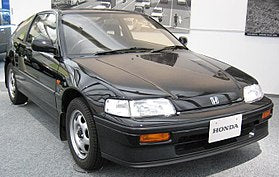
What does CR-X stand for? Learn more about the Honda CR-X.
What does CR-X stand for?

For the 1983 model year, Honda introduced an all-new two-seater that shared a powertrain with the Civic but offered unique styling and interiors. The Honda CR-X, originally released as the Honda Ballade Sports CR-X in Japan, is a front-wheel drive sports compact car manufactured by Honda, although many purported definitions exist for the acronym CR-X, the most widely accepted being "Civic Renaissance Experimental".
FIRST GENERATION
The first generation Honda CR-X was first produced in 1983 and is a lightweight sport compact. In the US market, the CR-X was marketed as a budget sports car, with room for just two passengers, but in Europe we know it as a 2+2. There were different engines, from 1.3 liters of displacement of the most economical model to the 1.6 liters of the “Si” model, known as ZC in Japan and D16A9 in Europe.
The CR-X was sold in some regions outside of Japan as the "Honda Civic CRX". At its introduction, the CRX was available in Japan through Honda Verno dealer sales channels, and was paired with the Vigor, Quint and Prelude.


SECOND GENERATION
Redesigned in 1988 through 1991, the CRX was very popular for its performance, especially the “Si” version, with nimble handling and good fuel consumption.
The chassis was changed significantly, from its original torsion bar at the front and beam axle and live axle at the rear to the 4-wheel double wishbone suspension in conjunction with its sister Civic/Ballade models. In Europe the second generation CRX was available with either a 1493 cc SOHC or an updated version of the 1590 cc DOHC ZC engine (D16A9 in Europe, catalyzed ones are called D16Z5). Many of them were equipped with fuel injection systems as standard.
VTEC-equipped models (B16A) also received a makeover, with updated bumpers, lights, hood, brakes, suspensions, and dash designs, among other things. Also, some of these design changes were added to the concurrent non-VTEC models.
He is known as Rex, since the pronunciation of CRX in English the last two letters, leave us this nickname.

CRX NO VTEC

CRX VTEC
MERITS
The CRX was the trending import car engine for 1984 and 1990. The second generation CRX in Si version was named number one in Road & Track's 10 Greatest Cars of All Time.


CR-X DEL SOL
In 1992, Honda replaced the CRX with a new targa-top Civic EG-based model called the Honda CR-X del Sol, also known simply as the Honda del Sol. The del Sol was also identified as the CR-X for this reason. that the del Sol is generally considered the "third generation CR-X" among enthusiasts, although it was arguably a very different car and Honda had seemingly quite different design goals when they built it.

In this generation in Europe we have two variants, the one known for mounting a 1.6-liter SOHC engine with VTEC that develops 125 hp (ESI) and the version that has the DOHC B16A2 engine, (B16A in Japan) with 160 hp ( VTI), which also has the system so characteristic of Honda.
The VTI version, being the top of the range, has an electric targa roof that opens and closes in a very peculiar way. We leave you a video below.
https://www.youtube.com/watch?v=4Ccn1ml9O7Q
And finally the production of the CR-X del Sol ended in 1997, so the CR-X line was retired, this being its last update.
